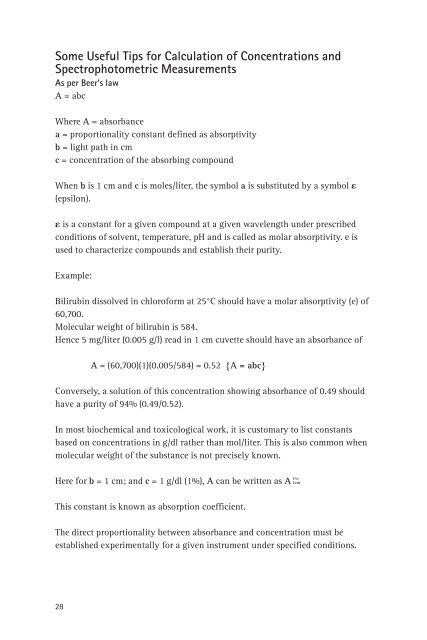A guide for the preparation and use of buffers in biological systems
A guide for the preparation and use of buffers in biological systems
A guide for the preparation and use of buffers in biological systems
You also want an ePaper? Increase the reach of your titles
YUMPU automatically turns print PDFs into web optimized ePapers that Google loves.
Some Useful Tips <strong>for</strong> Calculation <strong>of</strong> Concentrations <strong>and</strong><br />
Spectrophotometric Measurements<br />
As per Beer’s law<br />
A = abc<br />
Where A = absorbance<br />
a = proportionality constant def<strong>in</strong>ed as absorptivity<br />
b = light path <strong>in</strong> cm<br />
c = concentration <strong>of</strong> <strong>the</strong> absorb<strong>in</strong>g compound<br />
When b is 1 cm <strong>and</strong> c is moles/liter, <strong>the</strong> symbol a is substituted by a symbol e<br />
(epsilon).<br />
e is a constant <strong>for</strong> a given compound at a given wavelength under prescribed<br />
conditions <strong>of</strong> solvent, temperature, pH <strong>and</strong> is called as molar absorptivity. e is<br />
<strong>use</strong>d to characterize compounds <strong>and</strong> establish <strong>the</strong>ir purity.<br />
Example:<br />
Bilirub<strong>in</strong> dissolved <strong>in</strong> chloro<strong>for</strong>m at 25°C should have a molar absorptivity (e) <strong>of</strong><br />
60,700.<br />
Molecular weight <strong>of</strong> bilirub<strong>in</strong> is 584.<br />
Hence 5 mg/liter (0.005 g/l) read <strong>in</strong> 1 cm cuvette should have an absorbance <strong>of</strong><br />
A = (60,700)(1)(0.005/584) = 0.52 {A = abc}<br />
Conversely, a solution <strong>of</strong> this concentration show<strong>in</strong>g absorbance <strong>of</strong> 0.49 should<br />
have a purity <strong>of</strong> 94% (0.49/0.52).<br />
In most biochemical <strong>and</strong> toxicological work, it is customary to list constants<br />
based on concentrations <strong>in</strong> g/dl ra<strong>the</strong>r than mol/liter. This is also common when<br />
molecular weight <strong>of</strong> <strong>the</strong> substance is not precisely known.<br />
Here <strong>for</strong> b = 1 cm; <strong>and</strong> c = 1 g/dl (1%), A can be written as A<br />
1%<br />
1cm<br />
This constant is known as absorption coefficient.<br />
The direct proportionality between absorbance <strong>and</strong> concentration must be<br />
established experimentally <strong>for</strong> a given <strong>in</strong>strument under specified conditions.<br />
28
















